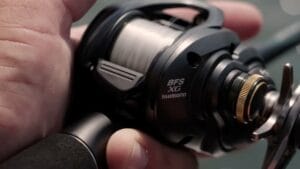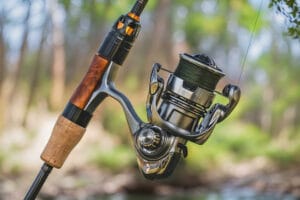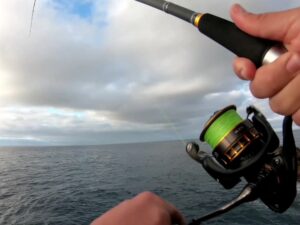Largemouth Bass
Even though largemouth bass are one of the most popular game fish in the USA. Many people don’t know much about them. We take a deep dive into everything to know about this amazing fish. Read more below.
Home » Knowledge Base » Species » Largemouth Bass – America’s Favorite Game Fish
Largemouth Bass - America's Favorite Game Fish
Common name: Largemouth Bass
Scientific name: Micropterus salmoides
Other names: American black bass, bigmouth bass, bucket mouth, bayou bass, green bass, green trout, lake bass, m salmoides
The Largemouth Bass, belong to the black bass family, and are one of the most, if not the most popular game fish for professional and beginner anglers alike and there’s good reason for this.
Not only can largemouth reach hefty sizes and weights (more on this in a minute), but few freshwater fish put up the same kind of fight and present the same kind of challenge as a largemouth bass will.
There’s a real satisfaction that happens when you pull in a true lunker and even in defeat you’re provided with so much material for overinflated stories about “the big one that got away.”
Largemouth bass are an integral part of the fishing community.
Despite this, many people have very little understanding about this hardy sport fish.
Today, we hope to shine some light onto the largemouth, bring about a new level of appreciation, and make you a better bass fisherman (or fisherwoman).
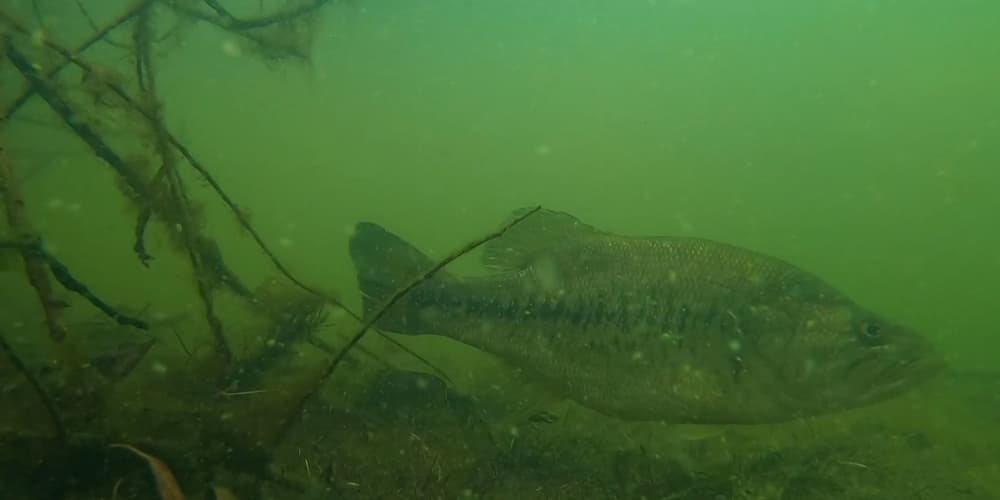
Key Characteristics
Largemouth bass are ambush predators.
They live most of their lives on the bottom of their habitat and normally only come up to the surface to feed.
This is why they are masters at camouflage.
The largemouth bass has evolved to be able to change the color of their back and sides to match the bottom of their environment.
This feature allows them to break up their outline as they lie in wait for their prey.
When a fish swims by, the largemouth bass will then burst from the cover of their environment and attack.
The largemouth bass has a sleek body that is built for power and performance.
The body is slender and muscular, and their pectoral fins are high on their body, which means they can use them as wings to help them burst from the cover of their surroundings to catch a prey fish.
They also have an enlarged lower jaw with sharp teeth.
Unlike a lot of other fish, the largemouth bass has a forked tail, which allows them to “whip” back and forth in the water to build up speed before they burst out of the cover of the river, lake, or ocean bottom.
Average Size of Largemouth
The largemouth bass is a very large, muscular fish.
The average largemouth bass is between 3 and 5 pounds, though, given the right environment, it can easily grow 2x to 3x this size and reach 20 pounds or more.
The current record largemouth bass was 22 pounds and 4 ounces, caught by George Perry on 6/2/1932.
Largemouth bass are very strong and powerful fish.
The largemouth bass’s average length is between 12 and 24 inches.
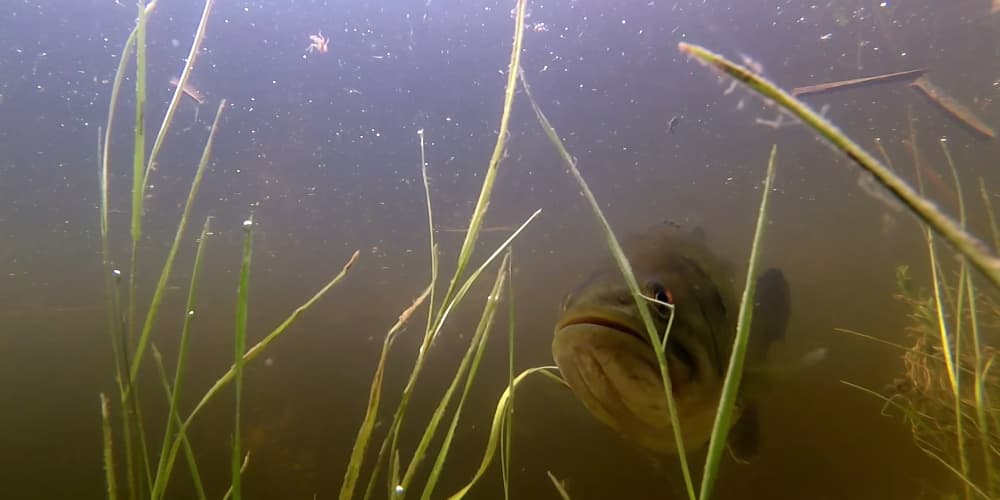
Habitat - Where do Largemouth Bass Live?
Largemouth bass can be found in freshwater throughout most of North America and even into Central and South America.
Largemouth typically thrive in warm, clear, lakes and rivers with a lot of submerged vegetation and cover for them to hide in.
They also prefer to live in areas with a good current, since it makes it easier for them to catch their prey.
If you see lots of underwater plants and weeds, the river or lake has good currents, and the water is clear, you are probably in an area inhabited by big healthy largemouth bass.
Feeding Patterns
The largemouth bass is a predator fish that feeds on smaller fish and insects.
The largemouth is a generalist fish and will eat a variety of prey.
This includes smaller fish, insects, frogs, crayfish, and salamanders, as well as small mammals.
Their diet consists of about 90% fish and 10% other prey items.
The largemouth has very sharp, pointed teeth that are designed specifically for grabbing, holding, and tearing apart their prey.
Largemouth bass are ambush predators.
They lie in wait for prey to pass by, then burst from their hiding place and attack.
They will lurk in the cover of the underwater plants or weed beds until a prey fish swims into range, then will leap out and grab it.
The largemouth bass is a master of its environment.
It is very difficult to sneak up on a largemouth bass because of their keen senses.
They are extremely alert and aware of their surroundings.
The largemouth bass’s eyes are on top of its head, giving them a great field of vision.
Breakdown of Largemouth Spawning Season
The Largemouth spawning season is effected largely by the water temperature, which will typically be in the 55-65 degree temperature in most regions throughout the US.
At the beginning of the spawning season, male largemouth bass will create nesting beds for the females. These nests are bowl shaped and will typically have a diameter of 20 to 30 inches.
Once the female lays the eggs, the male bass will stand watch over the nest to protect the young from predators.
Eggs will typically hatch between 2 and 10 days. Much of this length depends on the water conditions and temperature.
Fishing For Largemouth Bass
When fishing for largemouth bass, it’s important to take into consideration the information we’ve gone over so far as this will impact your fishing strategies.
You’ll want to consider taking advantage of their natural tendencies. Whether that’s dragging a lure next to a hiding spot to get a reaction strike, throwing a spinner bait during the mornings when the bass are coming to the surface to feed, or going down deep with a Texas rigged plastic worm when the temperature is hot.
By understanding the overall characteristics, mannerisms, and tendencies of largemouth bass you’ll be giving yourself a huge advantage when fishing for them.
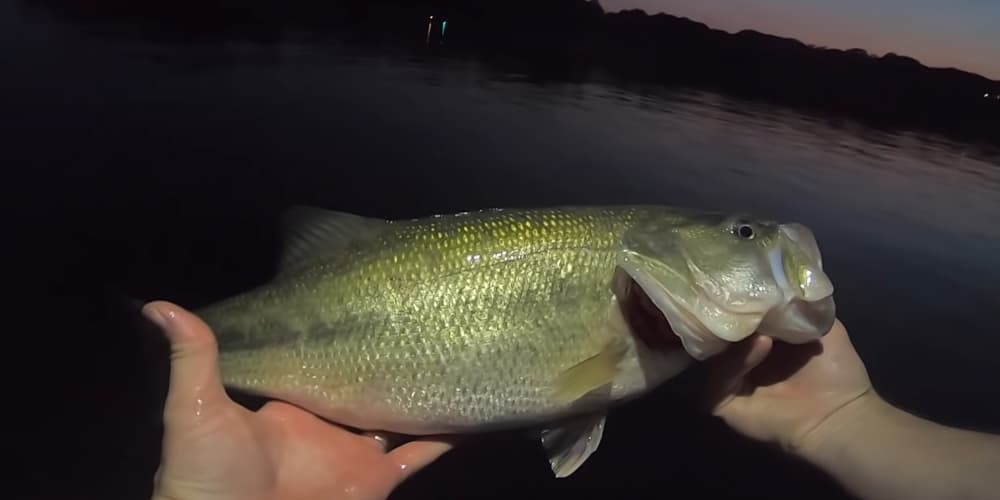
5 Fishing Tips for Catching Largemouth Bass
Now that you have a basic understanding of the largemouth bass, their tendencies, habitat, and preferred food, let’s go ahead and take a look at some specific strategies you can use to catch more of them.
1. Match the Hatch with Your Lures
Once you’ve gained an understanding of the largemouth’s natural tendencies, the next point of research is finding out about the natural prey in your particular fishing environment.
Bass are natural survivalists. Especially the trophy sized monsters that you’d write home to mom about.
If they weren’t, they would have never gotten old enough to reach that size. Because of this, largemouth are naturally wary of strange or foreign things.
They understand what their prey looks like and acts like, which is why it’s important for you to also understand this.
Why?
Well, because when you do, you can match your lures to what the largemouth are normally eating on any given day.
This is what “match the hatch means.”
Matching your lures to the look, color, and size of what the largemouth are eating in your body of water.
By doing this, you fool the bass into thinking your bait is just like the other food swimming around.
Here are some things to look for to help you do this.
Does your body of water have shiners, shad, forage fish, or another baitfish? – If so, try to match the size and color of the natural baitfish. Also, be mindful that their color may alter depending on their age. Adolescent baitfish may look different from adult.
Are their crawfish, crawdad, or crayfish (yes, they are all the same) where you fish at? – If you do have them, figure out when their spawning season is as bass will target crawfish during this time. Crawfish may change colors depending on the spawn, so try setting out a small trap near a rocky area along the edge of the water and catch a few. Match your crawdad bait color to what you caught.
Any frogs hopping around? – Largemouth love to gobble up some frogs. So if you see them hopping around or hanging out on the lily pads, get some topwater frog lures and match the look and color. Froggin’ is some of the best bass fishing around. You can get some amazing visuals as you see the bass come up out of the water to strike at your frog.
Insects, reptiles, fish, or other prey – Keep an eye out for other small creatures you see regularly. Even if you don’t think they’d be normal prey for a bass. If they’re the right size and get on or near the water, most likely they’ve been gobbled up by a largemouth.
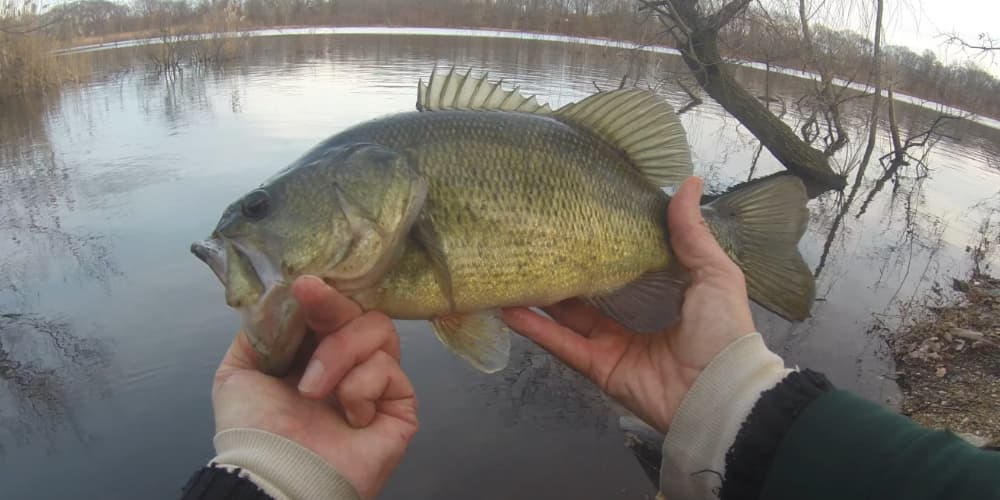
2. Watch the Water Temperature
It’s important to pay attention to the temperature of the water you’re fishing in. Largemouth prefer temperatures below 84 degrees Fahrenheit, though they’re able to function in temps between 39 and 90 degrees.
You’ll typically find largemouth will be most active in temperatures in the range of 70 to 80 degrees F.
There are a number of reasons for this, but one of the primary reasons is due to the dissolved oxygen level of the water. Warmer water holds less oxygen than colder water will, due to the interactions of oxygen and water at a molecularly level.
Since bass require higher levels of dissolved oxygen than many other fish species, they are going to tend to spend most of their time where breathing is easiest.
This is why, on hot days, when the water is warm, bass will tend to dive deeper down and hang out in deep cool pockets of water.
So, during the warmer months of the year, look for bass to feed near the surface in the morning and evening, and then dive to the cooler waters during the heat of the day.
3. Fish Where the Bass Are Hiding
Game fish are constantly looking for cover and structure to help them blend into the background, minimize their vulnerability and make it harder for their prey to see them.
The largemouth bass is no different.
One of the first things to look for when you’re on the water is structure.
What kind of structure is in the area and what kind of structure could be used by the largemouth bass to ambush their prey.
Largemouth will use things like underwater weeds, rock banks, and other structures to help them blend in.
This is why spending time on the water looking for structure is so important and this is something largemouth bass can use to their advantage.
Once you find structure, it’s a good idea to start fishing around it as this will increase the likelihood of a strike.
4. Understand How Weather Impacts Bass Behavior
Weather can have a major impact on your fishing experience as well as your success or failure.
During hot weather conditions, fish tend to move to deeper water.
The main reason for this is the temperature tends to be cooler and the water contains a larger amount of oxygen, which is important for the large amount of energy the largemouth will use during their active periods.
When it’s cold, the largemouth bass will be closer to the surface of the water.
During cold weather, the largemouth bass are looking to eat smaller prey like shad and other fish that will typically be near the surface of the water.
During warm days with strong winds, you can often have better success than normal, as all of the natural movement will help camouflage you and your movements and keep the bass from getting spooked.
When you have an understanding of how bass act during certain weather conditions, you can adjust your fishing tactics to increase your chances of success.
5. Research Before Hitting the Water
One of the best things you can do before heading out fishing for largemouth, is to do your research.
There is nothing that can take the place of personal experience, but doing some pre-fishing research will help.
If you’re new to an area, try to find out if there are any hotspots or recommended areas.
Make sure you check out the weather and any local fishing reports that are available.
Taking some time before hitting the water can help elevate your game.
Fishing is fun, but catching largemouth is funner (not a word 🙂
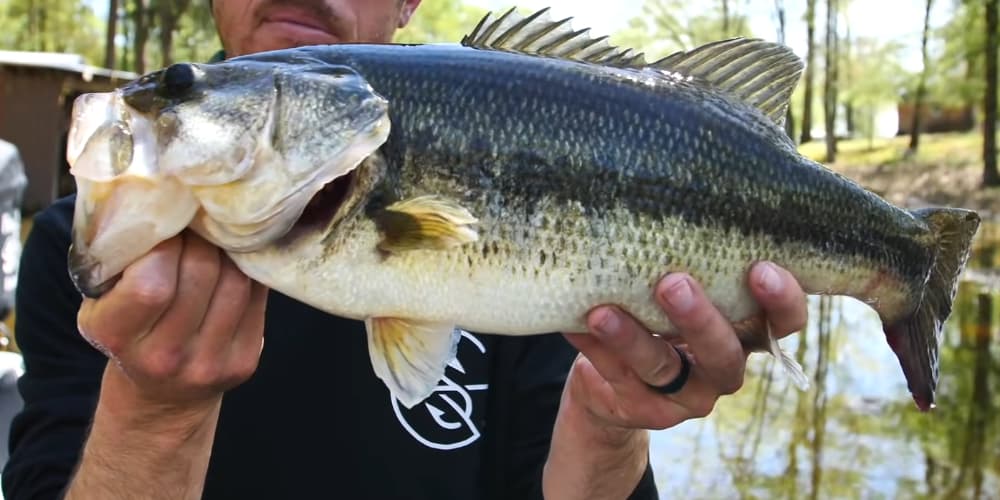
Top Largemouth Bass Fishing Destinations
When you’re planning a fishing trip, you’re going to want to consider choosing a location that has good bass populations with the particular species you’re wanting to target.
Here are some of the best places to go fishing for largemouth in the US, though in no particular order:
Chickamauga Lake, TN
A great place to go bass fishing is Chickamauga Lake. A large body of water built along the Tennessee River.
With over 36,000 acres of water, largemouth are plentiful, and it’s easy to find places where they’re biting.
Plus, this seems to be a trophy bass heaven, with anglers regularly catching bass over 10 pounds in this body of water.
Lake Okeechobee, FL
The bass fishing here is second to none, especially the Florida largemouth bass fishing on the south end.
This place is a regular stop for bass fishing tournaments and has been host to the Bassmaster Classic on multiple occasions.
Due to the warm climate of this 467,199 acre lake, largemouth fishing can be great year round, though you may have a harder time during the brutal heat of July-October.
Spawning season can run from November all the way to June. So there’s huge opportunity for some great Florida bass fishing.
Lake Guntersville, AL
Lake Guntersville is a great largemouth fishing destination.
Alabama’s largest lake. It’s a whopping 69,100 acres with loads of largemouth opportunities.
Plenty of drop offs, lay downs, underwater structure, and huge amounts of weed beds make Lake Guntersville a prime habitat for largemouth to grow into larger bass.
Sacramento-San Joaquin Delta, CA
The Sacramento-San Joaquin Delta is an extremely large and lengthy body of water, covering over 738,000 acres of land. It consists of a primary river and a whole lot of smaller rivers that eventually flow into the San Francisco Bay.
Sacramento-San Joaquin Delta is better known for striper fishing, but it’s also a great spot to catch hefty largemouth.
The best time to go bass fishing is during the fall, as the water temperature begins to drop.
This will bring more bait fish near the surface, which the largemouth will feed on.
The Delta is one of California’s oldest and fastest growing estuaries.
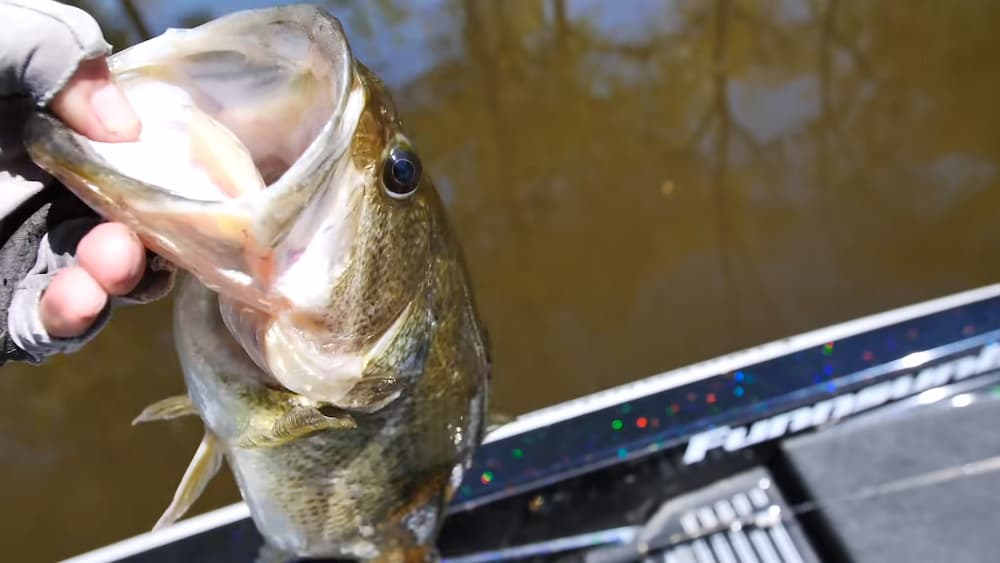
Lake Fork, TX
Lake Fork is one of the leading largemouth fishing destinations in the US.
With over 27,000 acres of water, a lot of underwater structure and aquatic vegetation, there’s plenty of opportunity to catch one you’ll be proud of.
It’s the perfect place to go to catch a lot of healthy trophy sized largemouth.
Largemouth fishing usually starts to heat up January through March before slowing down in the heat of summer.
If you’ve never fished at Lark Fork, you’ll want to put it on your short list.
St. Lawrence River, NY
The St. Lawrence River is a great location for both smallmouth bass and largemouth fishing.
Located in Upstate New York, St. Lawrence River takes up more than 395 million acres of land. This large river connects Lake Ontario and the other great lakes with the North East coast of Canada.
The largemouth fishing is best from the beginning of May through the end of July.
Focus your efforts on the shallow water and weedy bay areas, along the shoals, and in Lake of the Isles, and you’ll be sure to get something good!
Body of Water Near You!
These are just a few of the many amazing largemouth fishing spots throughout the US. So don’t limit yourself to a list.
It’s better to just get out and go fishing rather than trying to find the “perfect spot.”
Keep your eyes open to local bodies of water that around you.
Some great spots to drop a line include:
- On and around docks, piers, and pilings
- In weed beds with a good topwater
- On and around bridges
- Underwater structure, fallen trees, or other objects in the water where bass can hide
- Water drop offs
- Creeks running off of larger bodies of water
- Inlets, shoals, and outlets
There is so much fishing opportunities around you, you just have to go out and take advantage of them.
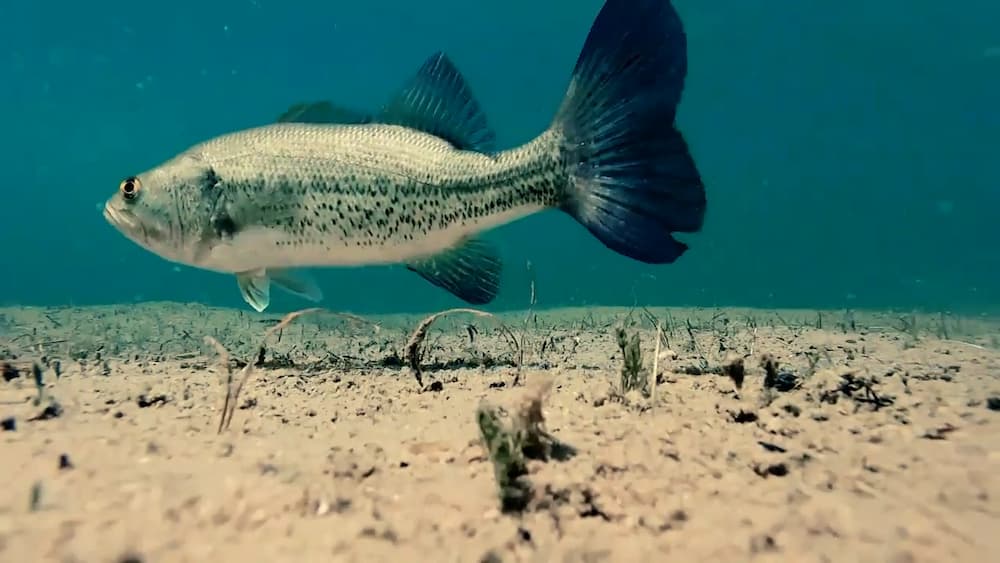
Conclusion - Preservation Responsibility
Always make sure you’re aware of the legal fishing requirements in your area along with any wildlife service restrictions on how many fish you can catch and keep.
Also, please remember to fish responsibly. We not only want to continue to enjoy this amazing pastime ourselves, but also pass on our fishing passion to our children and grandchildren.
If we don’t take care of our environment and protect largemouth from overfishing, that will never happen.
Last piece of advice, not only is catch and release important for bass survival, but also making sure you properly release them back into the environment. If you’ve pulled a bass up from 20 ft or deeper, make sure you fizz/vent the bass before releasing it back into the wild. Otherwise, their chances of survival greatly diminish.
You can quickly tell whether they’ve expanded with air as the area around below their dorsal fin will be expanded, and they will look enlarged.
Let’s take care of this amazing species, so we can continue to enjoy fishing for generations to come!
As an Amazon Associate I earn from qualifying purchases.

